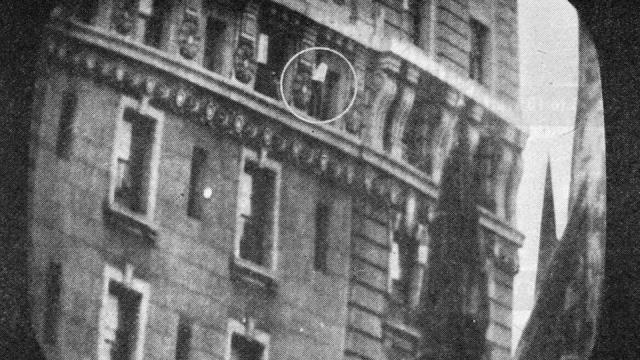The family of a Phoenix man who committed suicide this past September has filed a lawsuit against Fox News over the live broadcast of the event. Understandably, the family says that they suffered emotional distress after the broadcast, which was seen on TV sets and computer screens all over the world.
Anchor Shepard Smith apologized immediately after airing the suicide, but a national debate about the disturbing voyeurism of televised police chases ensued.
Sadly, very little of this debate about death on television is new. Suicide on TV is something that the medium has grappled with since its inception — before many people even knew how to properly define the technology.
On June 23, 1938, Marion Perloff jumped to her death from the 11th floor of the Time and Life building in New York City. This would have been just another suicide of many that would occur that year — America was still in the throes of the Great Depression — but something made this one particularly unique. It was the first suicide ever witnessed by TV cameras.
Television was still very much in its infancy in 1938. A bare-bones receiver might set you back $US400 (about $US6400 adjusted for inflation) and even if you were an early adopter with a set, there was very little programming to watch. But engineers from RCA were busy working on improving TV technology in 1938, ramping up their efforts for what was hoped to be TV’s big coming out party at the 1939 New York World’s Fair.
NBC cameraman Ross Plaisted was testing his video and audio equipment in Rockefeller centre when he spotted the 28-year-old Ms Perloff descending from the 11th floor. He picked up the shot when she’d reached the sixth floor and followed her with his lens all the way to the ground. A parabolic microphone picked up the deathly sounds and the gathering crowd’s commotion after her leap. The only people who saw the grisly images come flickering through were NBC engineers sitting in the third floor of the RCA Building. But despite the fact that it wasn’t broadcast, the woman’s tragic end was discussed as a dark milestone everywhere from Time magazine to radio trade publications to local newspapers throughout the US.
“Death for the first time flashed across a television screen,” Time declared. And it wouldn’t be the last. The second suicide scene ever caught by TV camera would occur just a month later and just a few blocks away. When 26-year-old John Warde stood on the 17th floor of the Gotham Hotel on 5th Avenue, the police and Warde’s family tried to coax him inside.
“SUICIDE NO. 2 TELEVISED!” read the grisly headline from the October 1938 issue of Radio-Craft magazine. Warde stood on the ledge of that 5th Avenue hotel for over 10 hours before jumping in front of a crowd of 10,000 horrified onlookers. The suicide was again not broadcast to a wide audience over the airwaves. But this time it was the lack of sunlight and a primitive distribution channel that saved early adopting New Yorkers from such a grisly sight in their homes.
Years later, moviegoers would also be spared from having to relive Warde’s demise. The 1951 film titled Fourteen Hours, which dramatises the last day of Warde’s life, ends with the disturbed young man surviving the fall. Unlike in the movies, live TV news cameras (whether they’re from the 1930s or today) can’t guarantee us a happy ending.
Picture: John Warde as seen from a TV camera in the October 1938 issue of Radio-Craft magazine
If mental illness is affecting you or someone you know, call Lifeline on 13 11 14.
